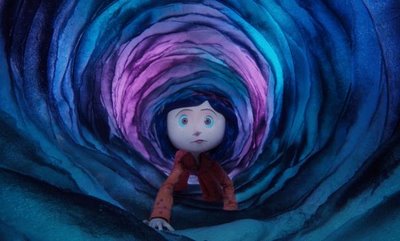The theme of “Coraline” is that not everything is what it appears to be. Until now, 3-D movies have sounded good on paper and have ended up gimmicky. But Henry Selick’s use of stop-motion animation and the new technology of RealD 3-D have made for what is easily the most visually stunning and deep animated movie I’ve ever seen.
It is quite beautiful yes. Most animated movies today are. And it’s not the best animated movie I’ve ever seen. There are even some classic artistic moments from other films I would favor over any in “Coraline,” such as the ballroom scene in “Beauty and the Beast,” the flight scene in “Toy Story,” watching WALL-E drag his hand through space as he clings to the rocket, or Jack’s Lament in front of the moon in “The Nightmare Before Christmas.” The story and portrayal of those films made those moments stand out from the background, but in “Coraline,” the artistry is in the foreground. It’s all so eye-catching and appealing, but it also does so much for the film’s dark setting.
Coraline (Dakota Fanning) has just moved into an old house in the country. Although she’s a bit of a brat, it’s hard to blame her as she’s ignored by her parents, her closest thing to a friend is a creepy, talkative boy, and the tenants above and below her are quite strange. But one night, she discovers a doorway into what seems to be an opposite world, with parents that listen and are fun, a friend she can relate to and neighbors that are mystical and charming. The only problem is, everyone in this new world has buttons for eyes.
The story is clever enough and it is well told and acted, but what’s hard to say is if the film has any deeper message. “The Nightmare Before Christmas” gave me the same impression, that it is a film that looks wonderful and is charming despite how creepy it is, but the story lacks the obvious appeals of something that dedicated more time to a plot than animation. I think the basic message is that life may seem bad, but giving up the things that are natural in life can turn into a disaster. It’s hard to assign the meaning of symbols like buttons for eyes, a talking cat or giant bugs, if any.
But I was so enchanted by the images I was seeing that the story began to fade into the background, and the film’s visual splendor became my focal point. Looking at “The Nightmare Before Christmas,” there are so many tiny details that populate the screen. “Coraline” has a magnificent attention to detail as well; it’s impossible to miss the father’s Michigan State sweater or the Volkswagen logo on the family car, not to mention the fine textures and symbols that appear on the hundreds of mice and dogs all doing tricks, and not a single one is identical.
But this new 3-D technology allows the film to have actual depth. In the past, 3-D movies would point a stick at the screen so it felt as though it was coming out. “Coraline” does this too, but tastefully and fluidly. During one of Coraline’s dreams, her paper constructions of mice come alive and begin to swim out of the screen and speak to the audience directly. Like I said however, the screen has actual depth. In wearing the 3-D glasses, we as the audience are inside the circus tent where the magical mice perform or we look out and see the luscious garden resembling Coraline’s face.
Given the depth the glasses creates, Selick makes excellent use of it, filling every nook and cranny of the seemingly infinite screen with colors, characters, figures, symbols and various details. But knowing however that he accomplished these vast and detailed landscapes with stop-motion animation is all the more amazing.
It should also be said that these images are quite bizarre and would be scary for a younger audience. The characters are odd to begin with, taking awkward shapes and appearances, but the elaborate scope of it all is what will likely creep out kids, as well as adults.
I tend to be one for a good story, compelling acting and meaningful morals. “Coraline” is a purely artistic movie however, and such a film will prove to be not for everyone and may have a chance of being excluded from my annual Top 10 list. But without a doubt, Selick’s achievement is a masterpiece, one that will eventually hold great influence on other works, both animated and not.
4 stars
